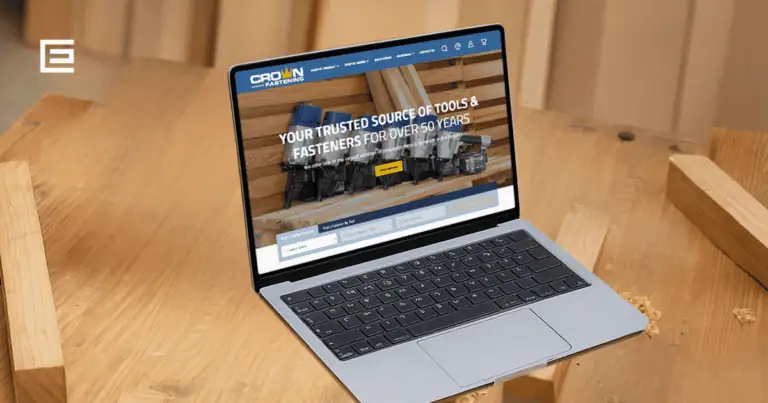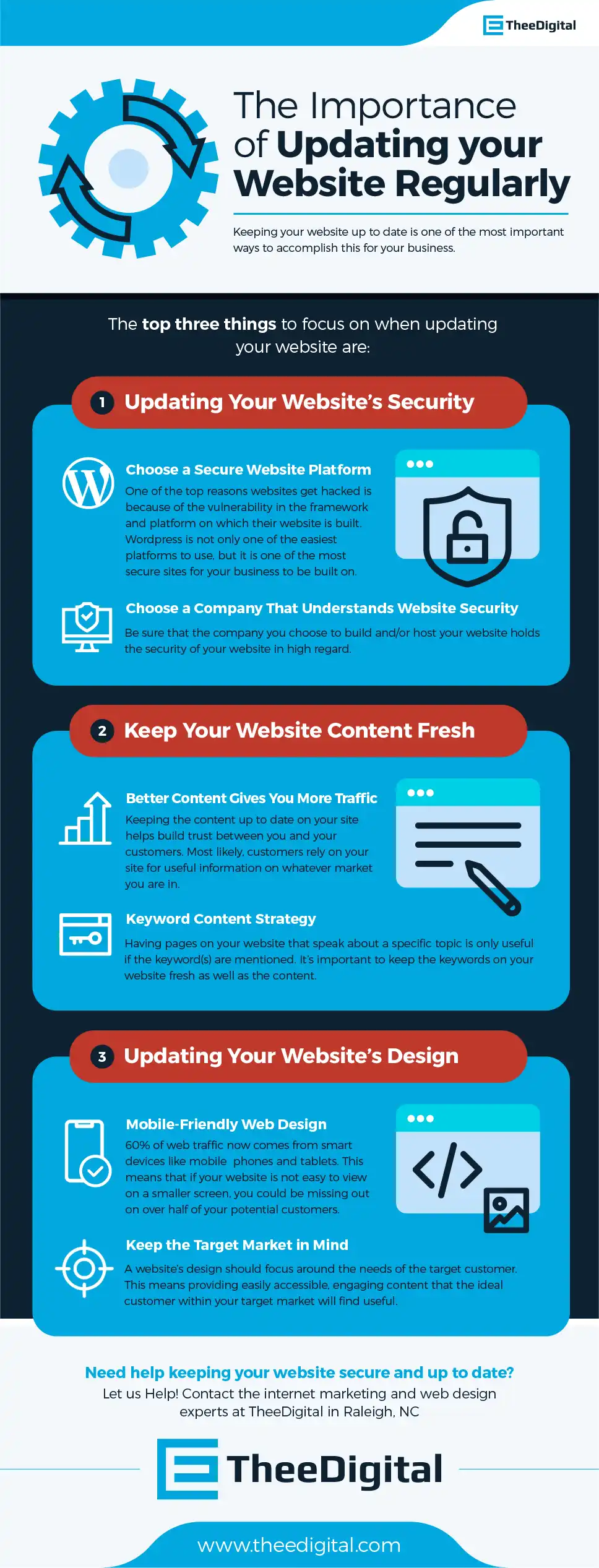Imagine you’re getting dressed for a job interview. Would you scan your wardrobe and choose the perfectly pressed outfit or the wrinkled shirt and pants that’s been soaking in your dirty hamper? You’d likely choose clean clothes because you want to make the best impression possible. And while we don’t judge – other people do. The same rule applies in the digital realm: you want to represent your brand in a way that is modern and clean. Let’s look at the benefits of regularly updating a website and how it could impact how people perceive your brand!
We aim to equip you with the knowledge and strategies needed to effectively revitalize your website, making it not only visually appealing but also functionally robust and aligned with your business objectives. Whether you’re looking to undertake a minor refresh or a major overhaul, this article will serve as your roadmap to a successful website update in 2023.
- 1Evaluating Your Current Website
- 2Planning Your Website Update
- 3Design and Visual Appeal
- 4Content Updates
- 5Technical Aspects of Website Updates
- 6User Experience and Navigation
- 7Testing and Feedback
- 8Launching Your Updated Website
- 9Maintenance and Regular Updates
- 10FAQs
- 11Final Word on Updating a Website
Evaluating Your Current Website
Before embarking on updating your website, it’s crucial to conduct a thorough evaluation of your current site. This initial assessment is akin to laying the groundwork for a successful renovation; it helps in identifying what’s working well and what needs improvement. Start by analyzing your website’s overall performance, which includes load times, responsiveness, and user navigation paths. Utilize tools like Google Analytics to gain insights into user behavior, such as the most visited pages, bounce rates, and user engagement metrics. This data provides a clear picture of the user experience and highlights areas that may be causing friction.
Next, turn your attention to the content and design aspects. Is your content up-to-date, relevant, and engaging? Does the design align with your brand identity and appeal to your target audience? Evaluate the visual elements, such as layout, color schemes, and imagery, ensuring they are not only aesthetically pleasing but also functional and accessible. Additionally, assess the technical aspects, including website security, SEO optimization, and mobile responsiveness. In today’s mobile-first world, ensuring your website is optimized for mobile devices is non-negotiable.
Identifying areas for improvement is a critical step in this process. It involves a comprehensive look at all facets of your website – from content and design to technical infrastructure. Prioritize these areas based on their impact on user experience and business goals.
For instance, if your website is not mobile-friendly, this should be high on your update list due to the increasing prevalence of mobile web browsing. Similarly, outdated content or poor user navigation can significantly affect user engagement and retention, warranting immediate attention. By methodically evaluating your current website, you set a solid foundation for an effective and impactful update.
Planning Your Website Update
The success of a website update largely hinges on meticulous planning. This phase is about setting clear, achievable goals and objectives, which will guide the entire update process. Begin by defining what you want to accomplish with the update. Are you aiming to enhance the user experience, improve SEO rankings, increase traffic, or refresh the brand image? Perhaps it’s a combination of these objectives.
Be as specific as possible; for instance, instead of a vague goal like “increase traffic,” aim for more measurable objectives like “increase website traffic by 20% in the next six months.” These specific goals will not only provide direction but also help in measuring the success of the update post-implementation.
Once your goals are set, the next step is to create a realistic timeline and budget. The timeline should outline key milestones and deadlines, from the initial design concepts to the final launch. It’s important to be realistic about the time required for each phase, considering factors like design complexity, content creation, and testing. Remember, rushing through the process can compromise the quality of the update.
Budgeting is equally crucial. Determine how much you are willing to invest in the update. This budget should cover all aspects, including design, development, content creation, and any tools or services you might need. If you’re working with external agencies or freelancers, get quotes early in the process to avoid surprises later on. Be sure to allocate a contingency fund for unforeseen expenses. A well-planned budget ensures that your website update is financially feasible and aligns with your business’s financial constraints.
In summary, effective planning of your website update, encompassing clear goals, a structured timeline, and a well-defined budget, is instrumental in ensuring a smooth, successful enhancement of your online presence.
Design and Visual Appeal
The design and visual appeal of your website play a pivotal role in capturing and retaining the attention of your visitors. In the digital age, where users form opinions about a website within seconds, a visually appealing design is not just a nicety—it’s a necessity. An updated design can rejuvenate your brand’s image, enhance user engagement, and set you apart from competitors. It’s about creating a balance between aesthetic appeal and functional usability, ensuring that your website is not only attractive but also intuitive and easy to navigate.
As we venture into 2023, several design trends are shaping the landscape of web aesthetics. Minimalism continues to reign, with a focus on clean layouts and uncluttered interfaces that prioritize content and ease of use. This trend aligns with the growing emphasis on mobile-first design, considering the increasing prevalence of mobile browsing. Another notable trend is the use of bold colors and gradients. These elements can infuse personality into your website and make it more memorable. However, it’s crucial to use them judiciously to avoid overwhelming your users.
Typography is also taking center stage, with creative and unique fonts becoming a tool for brand expression. The right typography can significantly enhance your website’s visual impact and user experience. Additionally, the integration of advanced technologies like augmented reality (AR) and virtual reality (VR) is starting to make waves, offering immersive and interactive experiences to users.
Incorporating these design trends into your website update requires a thoughtful approach. It’s essential to align them with your brand identity and the preferences of your target audience. The goal is to create a visually appealing website that resonates with your users and reinforces your brand message. By embracing these latest design trends, your website will not only look contemporary but also provide an engaging and seamless experience to your visitors.
Content Updates
Updating the content of your website is as crucial as revamping its design. Content, after all, is what communicates your brand’s message and engages with your audience. The first step in this process is to identify which content needs updating. Start by reviewing your current content for relevance, accuracy, and engagement. Look for outdated information, broken links, or pages that no longer align with your brand’s message or goals. Analyzing user engagement metrics can also highlight content that is underperforming or not resonating with your audience.
Once you’ve identified the areas needing attention, it’s time to focus on best practices for content updates. The key is to create high-quality, relevant content that adds value to your audience. This could mean rewriting product descriptions to be more compelling, updating blog posts with current information, or creating entirely new content that addresses the latest trends or customer needs. It’s also important to maintain a consistent tone and style that reflects your brand’s personality and resonates with your target audience.
SEO considerations are integral during content updates. Your content should not only be informative and engaging but also optimized for search engines. This means incorporating relevant keywords naturally, optimizing meta tags and descriptions, and ensuring your content is structured in a way that search engines can easily crawl and index. Updating your content provides an excellent opportunity to improve your website’s SEO, potentially leading to higher search engine rankings and increased traffic.
Remember, content is not just about text. It includes images, videos, infographics, and other multimedia elements. These should be updated to complement your text content, enhance user engagement, and provide a richer user experience. By focusing on these aspects of content updates, you ensure that your website remains relevant, informative, and appealing to both your audience and search engines.
Technical Aspects of Website Updates
When updating a website, it’s crucial to address the technical aspects that underpin its functionality and performance. These technical updates are essential for ensuring that your website operates smoothly, securely, and efficiently.
Firstly, ensuring website functionality is paramount. This involves checking and refining the site’s underlying architecture and code. It’s important to fix any existing bugs, broken links, or errors that could hinder the user experience. Regularly testing different features of your website, such as contact forms, navigation menus, and e-commerce functionalities, ensures they work as intended. This proactive approach helps in maintaining a professional, reliable online presence.
Updating plugins and software is another critical aspect. Outdated plugins and software can lead to security vulnerabilities, compatibility issues, and reduced functionality. Regular updates are necessary to protect your website from security threats like malware and hacking attempts. These updates often include new features and improvements that can enhance your website’s capabilities. If you’re using a content management system (CMS) like WordPress, keeping the core software and any installed plugins or themes up to date is essential for the smooth running of your site.
Mobile responsiveness and speed optimization are also key areas to focus on during a website update. With the increasing use of smartphones and tablets for internet browsing, your website must perform well across all devices. This means having a responsive design that adjusts seamlessly to different screen sizes and orientations. Additionally, website speed is a critical factor in user experience and search engine optimization (SEO). Optimizing images, minimizing code, leveraging browser caching, and using a content delivery network (CDN) can significantly improve your website’s loading times. Faster websites not only provide a better user experience but also tend to rank higher in search engine results.
By addressing these technical aspects, you ensure that your website is not only aesthetically pleasing but also robust, secure, and responsive. This holistic approach to website updates is essential for delivering a superior user experience and maintaining a strong online presence.
User Experience and Navigation
In the realm of website updates, enhancing the User Experience (UX) is a cornerstone for ensuring visitor satisfaction and engagement. UX encompasses all aspects of the end-user’s interaction with your website, from the ease of navigation to the emotional response elicited by the site. A positive UX is crucial for retaining visitors, reducing bounce rates, and ultimately converting visits into actions, whether they be sales, sign-ups, or engagement with content.
Improving UX starts with understanding your audience. Utilize user feedback, analytics, and usability testing to gain insights into how visitors interact with your site. Are they finding what they need easily? Are there any points of frustration or confusion? Addressing these questions can guide you in making informed decisions about layout, content, and functionality. For instance, simplifying complex processes, like checkouts or sign-ups, can significantly enhance the user experience. Additionally, ensuring your website is accessible to all users, including those with disabilities, is not just a best practice but also a legal imperative in many regions.
Streamlining website navigation is another critical element in improving UX. Your website’s navigation should be intuitive and straightforward, allowing users to find information quickly and effortlessly. This can be achieved by having a well-structured menu, logical page hierarchies, and clear, descriptive labels. Breadcrumbs, search bars, and well-organized sitemaps can also aid in navigation, especially for more extensive websites. Remember, the goal is to minimize the number of clicks it takes for a user to reach their desired content.
Moreover, the continued rise of mobile internet usage necessitates that navigation is optimized for touch screens and smaller displays. This might involve designing mobile-friendly menus, such as hamburger menus, and ensuring that clickable elements are adequately sized for touch interaction.
By focusing on user experience and navigation, you not only make your website more enjoyable and easier to use but also increase the likelihood of visitors returning and engaging more deeply with your content or services. A well-designed UX and streamlined navigation are not just about aesthetics; they are about creating a seamless, efficient, and enjoyable journey for your users.
Testing and Feedback
In the process of updating a website, testing and feedback play pivotal roles in ensuring that the changes made are effective and align with user expectations. These steps are crucial for validating the updates and making informed decisions to further enhance the website’s performance and user experience.
Testing
A/B testing, or split testing, is a powerful tool in this phase. It involves comparing two versions of a web page to see which one performs better in terms of user engagement, conversion rates, or other predefined metrics. For example, you might test two different homepage designs, call-to-action buttons, or content layouts to determine which version resonates more with your audience. A/B testing provides concrete data on user preferences and behaviors, allowing you to make evidence-based decisions. This methodical approach helps in optimizing the website for better results, rather than relying on guesswork or subjective opinions.
User Feedback
Gathering and implementing user feedback is another critical aspect of the testing phase. Feedback can be collected through various channels such as surveys, user testing sessions, feedback forms, or social media interactions. Pay attention to what users say about the usability, aesthetics, content, and overall experience of your website. This direct input from the end-users is invaluable as it provides insights that you might not have considered or been aware of.
Once feedback is collected, it’s essential to analyze and prioritize it for implementation. Not all feedback will be actionable or align with your website’s goals, so it’s important to discern which suggestions will have the most significant impact on improving your website. Implementing changes based on user feedback demonstrates to your audience that you value their input and are committed to providing them with the best possible experience.
In summary, A/B testing and user feedback are integral components of the website update process. They ensure that the changes made are not just aesthetically pleasing or technically sound, but also effective in meeting the needs and expectations of your users. By embracing these practices, you can refine your website to better serve its purpose and enhance user satisfaction.
Launching Your Updated Website
The launch of your updated website marks a significant milestone in your digital presence. However, the process requires careful preparation and strategic planning to ensure a smooth transition and successful unveiling.
Preparing for Launch
Before going live with your updated website, it’s crucial to conduct a final round of checks and preparations. This includes a comprehensive review of the website’s functionality, ensuring all features, links, and forms work correctly. It’s also important to verify that the website is optimized for different browsers and devices, ensuring a consistent experience across all platforms. Additionally, double-check your SEO elements like meta titles, descriptions, and keywords to ensure they are properly in place for search engine visibility.
Load testing is another critical step, especially if you anticipate a significant increase in traffic. This process involves simulating virtual users accessing your site to ensure that it can handle high traffic volumes without performance issues. Also, make sure that all old URLs are properly redirected to the new ones to maintain SEO value and user accessibility.
Post-launch Considerations
Once your website is live, the work doesn’t stop there. Post-launch, it’s essential to monitor the website closely for any issues that might arise. This includes checking for broken links, monitoring site speed, and ensuring all functionalities are working as expected. Be prepared to make quick fixes for any unforeseen glitches.
Post-launch is also the time to gather initial feedback from users. Encourage your audience to provide feedback on the new design and functionality. This can be done through surveys, feedback forms, or direct communication channels like social media or email. Pay close attention to this feedback, as it can provide valuable insights for further refinements.
Additionally, keep an eye on your website analytics. Monitor how the new updates are affecting user behavior, traffic, and engagement metrics. This data will help you understand if the new updates are moving you closer to your defined goals and what adjustments might be needed to improve performance.
Finally, don’t forget to update your marketing materials and announcements to align with your website’s new look and features. This could include updating social media profiles, email signatures, and any digital or print materials that feature your website.
In summary, launching your updated website is a critical phase that requires meticulous preparation and ongoing attention post-launch. By carefully planning and monitoring, you can ensure a successful rollout and continued improvement of your website.
Maintenance and Regular Updates
After the launch of your updated website, it’s crucial to recognize that website management is an ongoing process. Regular maintenance and updates are key to ensuring that your website continues to function optimally and stays relevant in a rapidly changing digital landscape.
Importance of Regular Website Maintenance
Regular maintenance is essential for several reasons. Firstly, it helps in keeping your website secure. With cyber threats evolving constantly, regular updates to your website’s security measures are crucial to protect sensitive data and maintain user trust. Secondly, it ensures that your website runs smoothly. This includes updating software and plugins, fixing broken links, and addressing any errors that may arise. Regular maintenance also plays a significant role in SEO. Search engines favor websites that are regularly updated with fresh content and well-maintained in terms of technical health.
Moreover, regular maintenance allows you to adapt to user feedback and analytics. By continuously monitoring how users interact with your site and what they respond to, you can make informed adjustments to improve the user experience and engagement.
Schedule for Ongoing Updates
Creating a schedule for ongoing updates is a proactive approach to website management. This schedule should include routine tasks such as checking for software updates, scanning for security vulnerabilities, and backing up your website data. These tasks might be weekly or monthly, depending on the specific needs of your website.
Content updates should also be part of this schedule. Plan regular reviews of your website’s content to ensure it remains accurate, relevant, and engaging. This could be a quarterly or bi-annual task, where you assess and update your blog posts, product information, or any other key sections of your site.
It’s also wise to schedule periodic reviews of your website’s overall performance and design. This could be an annual task where you evaluate the website’s design trends, user experience, and technological advancements. Such reviews can help in identifying opportunities for more significant updates or redesigns to keep your website at the forefront of digital trends.
In summary, maintenance and regular updates are not just about fixing what’s broken; they’re about proactively managing and improving your website to ensure its long-term success and relevance. By establishing a routine for these tasks, you can ensure that your website remains a robust, secure, and engaging platform for your users.
FAQs
When it comes to website updates, there are several common questions that often arise. Here are some frequently asked questions based.
How often should I update my website?
The frequency of website updates depends on various factors, including the nature of your business, changes in technology, and user feedback. Generally, it’s recommended to review and update your website content every few months, while more significant redesigns or functionality updates might be needed every 2-3 years. However, regular monthly checks for technical updates, like software or security patches, are crucial.
What are the key signs that my website needs an update?
Indicators that your website needs an update include decreased user engagement, lower search engine rankings, outdated design or content, slow loading times, and non-compliance with current web standards, such as mobile responsiveness and accessibility guidelines.
Can updating my website improve its SEO?
Yes, updating your website can significantly improve its SEO. Regular updates with high-quality, relevant content can boost search engine rankings. Technical improvements, such as faster loading times and mobile responsiveness, also positively impact SEO.
Should I focus more on design or content during an update?
Both design and content are equally important and should be given careful consideration during an update. A visually appealing design attracts users, while compelling and relevant content keeps them engaged. Balancing both aspects is key to a successful website.
How do I ensure my updated website aligns with my brand?
To ensure your updated website aligns with your brand, maintain consistency in visual elements like colors, fonts, and logos. The tone and style of your content should also reflect your brand’s voice and values. Regularly revisiting your brand guidelines during the update process can help maintain this alignment.
What is the best way to gather user feedback for website updates?
User feedback can be gathered through surveys, feedback forms on your website, social media interactions, and direct customer inquiries. Analyzing user behavior through tools like Google Analytics also provides insights into how users interact with your site.
How do I measure the success of my website update?
The success of a website update can be measured through various metrics such as increased traffic, improved search engine rankings, higher user engagement (like longer session durations and lower bounce rates), and achieving specific goals set before the update (like increased sales or sign-ups).
Final Word on Updating a Website
A key takeaway is the importance of regular maintenance and updates. Keeping your website up-to-date is not a one-time task but an ongoing commitment to excellence. Regular updates ensure that your website remains secure, functional, and aligned with the latest digital trends and user expectations. They are essential for staying relevant in an ever-evolving digital landscape.
As you move forward, remember that a website is never truly ‘finished.’ It’s a dynamic entity that should evolve with your business, technology, and user needs. Continuous improvement should be your mantra, guided by user feedback, performance metrics, and industry trends. Stay proactive in seeking ways to enhance your website, whether through small tweaks or significant overhauls.
In essence, your website is a reflection of your brand and a key touchpoint for your audience. By investing in regular updates and improvements, you not only enhance its functionality and appeal but also reinforce your commitment to providing value to your users. Keep pushing the boundaries of what your website can achieve, and you’ll continue to reap the rewards of a robust and engaging online presence.
Need help keeping your website secure and up to date?
Let us Help! Contact the internet marketing and web design experts at TheeDigital in Raleigh, NC at 919-341-8901 or schedule a consultation today.
Tags: Digital Marketing • Web Design








